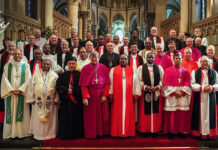In a letter of 2 July this year to the signatories of a letter from the Alliance group within the Church of England to the Archbishops of Canterbury and York the Bishop of Oxford wrote as follows:
‘The mind of the majority House of Bishops now seems to me to be settling on questions of pastoral reassurance after many months of uncertainty. There is a now a reluctant acceptance of the need for some regional provision of episcopal ministry to recognise divergent views on marriage and same sex relationships, supported by a House of Bishops statement, Code of Practice and Reviewer. However, the House is also clear that going beyond these arrangements to diverse jurisdictions, a third province and a church within a church undercuts the very essence of Anglican ecclesiology and represents a red line we cannot cross.’
The references in the final sentence of this quotation to ‘diverse jurisdictions,’ ‘a third province’ and ‘a church within a church’ are all different ways of referring to the same idea, the idea put forward by the Alliance and the Church of England Evangelical Council (CEEC) that in the event that the House of Bishops and the General Synod continue down the path of permitting the blessing of same-sex sexual relationships and allowing those in same-sex sexual relationships to serve as ordained Church of England ministers, a third province of the Church of England should be created to provide a secure and permanent home for those who cannot in good conscience accept these developments.
The Bishop of Oxford rejects this idea on the grounds that it ‘undercuts the very essence of Anglican ecclesiology’ and therefore ‘represents a red line we cannot cross.’ What he does not explain in his letter, and what he has not explained elsewhere, is why the proposal for a third province goes against ‘the very essence of Anglican ecclesiology.’
It is very difficult to see why he thinks is the case.
It cannot be because those seeking a third province are rejecting the basic ecclesiological principle that members of the visible Church have an obligation to be in Christian fellowship with other members of the visible Church. Those seeking a third province are not doing this. They do want to remain in Christian fellowship with other members of the Church of England. However, they want to do so in a way that allows them to visibly differentiate themselves from what they believe to be very serious errors in theology and practice with regard to human sexual identity and behaviour. [1]
It cannot be because a national Anglican church can only ever have two provinces. There is nothing in any statement of Anglican ecclesiological principle that states that there can only be a maximum of two provinces in a single national Anglican jurisdiction. That is why it is not seen as a problem that the Anglican Church of Canada has four provinces, that the Anglican Church of Australia has five provinces and one extra provincial diocese, and that the Anglican Church of Nigeria has fourteen provinces. [2]
It cannot be because the new province would be ecclesiologically different from the two existing provinces. This would not be case. Like the two existing provinces, the new province would fufil the basic ecclesiological criterion of being a ‘congregation of faithful men, in the which the pure Word of God is preached, and the Sacraments be duly ministered in all those things that of necessity are requisite to the same’ (Article XIX). Like the two existing provinces, the new province would also consist of a number of dioceses under the episcopal oversight of an archbishop and a number of other bishops. The dioceses would operate in the same way as the current dioceses of the Church of England and would adhere to the Church of England’s current Canon Law.
It cannot be because, as is sometimes suggested, the new province would a ‘non-geographical’ province. It would be geographical in the sense that, as in the case of the two existing provinces, the new province would have geographical boundaries, its dioceses would have geographical boundaries, and it would be made up of parishes each of which would have geographical boundaries.
It cannot be because a new province would create parallel episcopal jurisdictions thus violating the ancient principle reflected in the eighth canon of the Council of Nicaea that there should not be ‘two bishops in one city.’ The reason that there would not be parallel episcopal jurisdictions is that the dioceses of the new province would consist of a set of parishes that were different from the parishes remaining in Canterbury or York. It would therefore not be the case that the same parish would come under the jurisdiction of both a bishop from the new province and a bishop from Canterbury or York. Parallel jurisdiction would thus not exist.
It cannot be because the dioceses of the new province would be made up of parishes that were geographically scattered rather than being contiguous. There is nothing in Anglican ecclesiology that says that all the parishes in a diocese have to abut another parish in the same diocese. Until the Victorian period parishes that were geographically detached from other parishes in the same diocese were an accepted phenomenon. A classic example is the ancient parish of Croydon which was historically a detached part of the diocese of Canterbury.
It cannot be because the creation of a new province would involve parishes ceasing to be under the ordinary jurisdiction of their existing diocesan bishop. This is not a ecclesiological problem because it has historically been accepted both that new dioceses can be created and that parishes can be transferred between existing dioceses. Both of these situations involve parishes moving out of the ordinary jurisdiction of their existing diocesan bishop and coming under the ordinary jurisdiction of a new diocesan bishop instead. Exactly the same process would take place in the case of parishes joining the dioceses of the new province.
Finally, it cannot be because the new province would differ from the other two provinces of the Church of England in parts of its theology and practice. The Church of England has already accepted the principle that parishes of the Church of England can differ from one another theologically over the issue of the ordination of women and express these differences in their practice. It is also proposed by the House of Bishops that the same will be true over the issue of human sexuality. If differences in theology and practice are thus judged to be theologically acceptable at the parochial level, then there can be no coherent objection to them also existing at the diocesan and provincial level given that diocese and provinces are ultimately just collections of parishes. To put it simply, if a parish can differ from other parishes in its theology and practice and still be part of the Church of England, why cannot a group of parishes (organised as a diocese or a province) do the same?
If we rule out these reasons for seeing a third province as ecclesiologically unacceptable then what the Bishop of Oxford (or some other members of the House of Bishops) needs to explain is why the House of Bishop refuses to entertain the idea of a third province. What, really, is their problem?
[1] It is worth noting that the principle of differentiation because of differences of theology and practice has been an accepted part of Church of England ecumenical policy, which has always held that there can only be that degree of visible unity between churches that is permitted by their degree of agreement on matters of faith and order.
[2] Church historians will also be aware that between 787 and 796 the Church of England consisted of three Provinces, since Lichfield was an archdiocese, and that the United Church of England and Ireland which existed from 1800-1871 originally consisted of six provinces, Canterbury, York, Armagh, Dublin, Cashel and Tuam.










